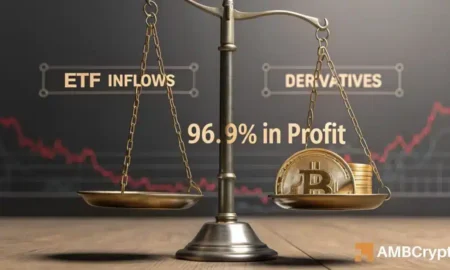Chainlink’s Price Volatility: A Deep Dive into Recent Market Movements
Recently, Chainlink (LINK) experienced a significant surge in activity following a remarkable transaction involving a whale deposit of nearly $25 million. The event, marked by the transfer of 1,999,999 LINK to Binance, left traders and analysts speculating about the implications for the cryptocurrency. Such whale movements are historically linked to liquidation, rather than signals of long-term investment. As LINK remains in recovery, the market is poised for possible turbulence, raising questions about whether this transaction indicates a forthcoming downturn or is merely a false alarm.
Massive Exchange Inflows Hinting at Potential Sell Pressure
The whale’s transfer was accompanied by an astonishing 8483% increase in the Large Holder Netflow to Exchange Netflow Ratio. This significant spike is noteworthy as it generally suggests that large holders are preparing to distribute rather than accumulate their assets. Historically, such aggressive shifts rarely occur without consequences. If major sell-offs follow, LINK could face an immediate bearish trend. The implications of such a large flow cannot be overstated, especially in an already precarious market landscape.
Conflicting Valuation Signals: The NVT and MVRV Ratios
Two critical metrics—NVT ratio and MVRV Z-Score—point to a conflicting state of valuation for LINK. The NVT Ratio for Chainlink stands at 751, indicating that its market capitalization significantly exceeds current transaction volumes. This disconnect typically arises when speculative demand inflates prices without adequate on-chain activity, forecasting potential declines unless network utility improves. Conversely, the MVRV Z-Score has dipped to -0.78, indicating that many holders are currently underwater, which often suggests undervaluation. Despite this, the ongoing spikes in exchange inflows and whale activities could complicate the situation, making it tough for investors to decipher the true state of the asset.
Exchange Netflows Are Surging
In conjunction with the whale transaction, Exchange Netflows for LINK saw a dramatic increase of 771.44%, amounting to nearly 10 million LINK flooding exchanges. This influx raises the probability of heightened sell pressure, suggesting that traders intend to offload their holdings. When inflows of this magnitude occur, they typically signal a lack of long-term confidence among holders. Should buyer interest fail to keep pace with the rising inflows, LINK’s price is likely to face downward pressure, particularly as market sentiment already leans toward caution.
Key Price Levels to Watch
As of the latest updates, LINK trades around $12.67, just above a crucial support level at $12.42. Historically, this support has provided a safety net for the asset. However, the current trajectory indicates that the price is moving within a descending channel, with a resistance level emerging near $15.61. As the price compresses within this channel, traders are faced with a critical decision point. A breach below $12.42 could lead to targets around $10.05 or lower, while a recovery bounce—if it occurs—may be limited without stronger underlying fundamentals.
Conclusion: Is a Breakdown Imminent for Chainlink?
The metrics surrounding Chainlink present a largely bearish outlook: increased whale inflows, weakening utility, and conflicting valuation signals point to a challenging landscape ahead. While the MVRV Z-Score may suggest potential undervaluation, it clashes with multiple sell indicators flooding into the market. Unless Chainlink witnesses renewed organic demand or successfully breaks above trendline resistance, the risks of a downturn remain prevalent. For investors and enthusiasts alike, the coming days will be crucial in determining LINK’s future trajectory amidst the ongoing volatility.
















